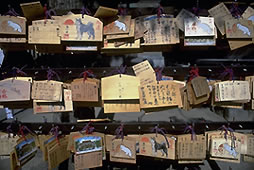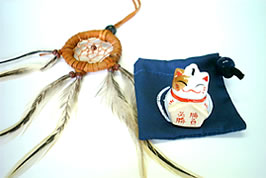An ornament of a cat with a forepaw raised, a crystal figure in the shape of an owl, an earpick with a little, red Buddhist daruma doll attached--what do these things have in common? They're all good luck charms that Japanese kids want to have as they prepare for school entrance examinations.
 When you have a wish that you really want to come true, what do you do? In Japan, people traditionally go to a shrine or a temple and write their wish (or thanks if a wish came true) on a wooden tablet--called ema--that has a picture of a horse (or sometimes another animal) on the back, and then hang the tablet at the temple or shrine. People long ago believed that the gods rode horses, and so an ema is a way of asking the gods to come and help.
When you have a wish that you really want to come true, what do you do? In Japan, people traditionally go to a shrine or a temple and write their wish (or thanks if a wish came true) on a wooden tablet--called ema--that has a picture of a horse (or sometimes another animal) on the back, and then hang the tablet at the temple or shrine. People long ago believed that the gods rode horses, and so an ema is a way of asking the gods to come and help.
Japan is well known for intense competition to enter schools. Beginning around every New Year, swarms of people visit the Shinto shrines that worship the gods of learning and Buddhist temples dedicated to Monju Bosatsu, the bodhisattva (enlightened person) of wisdom and learning, and the grounds of these temples and shrines are filled with ema. Almost all of the tablets ask for help in passing school entrance examinations, which are held in February and March.
Nowadays, though, when Japanese kids have a hard time, they don't just turn to the gods for help. When entrance-examination season rolls around, kids put good luck charms like the ones above on their desks or attach them to their cellular phones.
One good luck item that is extremely popular recently is an admission ticket to a train station on the island of Shikoku. The name of the station is Gaku. The kanji for gaku is the same as the first kanji in gakko, which means "school," so the ticket could be read as being an admission ticket to school.
A statue of a cat with a forepaw raised, known as maneki-neko, has long been known in Japan as a symbol of good luck. The curled paw is used to beckon people. In Japan, turning the palm downward and fluttering it doesn't mean "go away"; it means "come here."
 Also for sale are figures of Jizo, a bodhisattva that keep kids safe; pens with a red Buddhist daruma doll, a symbol of strength and good luck, attached at the end; and a traditional good luck charm of Native Americans called a "dream catcher." Some of the more unusual items include a snack called "intellect bread" that has a drawing of a professor on the wrapper and underwear that has the Shichifukujin (the Seven Deities of Good Fortune) printed on it. It seems that Japanese kids have a lot of powerful allies as they prepare for entrance examinations.
Also for sale are figures of Jizo, a bodhisattva that keep kids safe; pens with a red Buddhist daruma doll, a symbol of strength and good luck, attached at the end; and a traditional good luck charm of Native Americans called a "dream catcher." Some of the more unusual items include a snack called "intellect bread" that has a drawing of a professor on the wrapper and underwear that has the Shichifukujin (the Seven Deities of Good Fortune) printed on it. It seems that Japanese kids have a lot of powerful allies as they prepare for entrance examinations.
Photos:(Top) Many kids write the name of the school they want to go to on ema; (above) they also keep good luck charms, like this miniature dream catcher, left, and a figurine of a cat holding a tablet with words that ensure victory.

 When you have a wish that you really want to come true, what do you do? In Japan, people traditionally go to a shrine or a temple and write their wish (or thanks if a wish came true) on a wooden tablet--called ema--that has a picture of a horse (or sometimes another animal) on the back, and then hang the tablet at the temple or shrine. People long ago believed that the gods rode horses, and so an ema is a way of asking the gods to come and help.
When you have a wish that you really want to come true, what do you do? In Japan, people traditionally go to a shrine or a temple and write their wish (or thanks if a wish came true) on a wooden tablet--called ema--that has a picture of a horse (or sometimes another animal) on the back, and then hang the tablet at the temple or shrine. People long ago believed that the gods rode horses, and so an ema is a way of asking the gods to come and help.
 Also for sale are figures of Jizo, a bodhisattva that keep kids safe; pens with a red Buddhist daruma doll, a symbol of strength and good luck, attached at the end; and a traditional good luck charm of Native Americans called a "dream catcher." Some of the more unusual items include a snack called "intellect bread" that has a drawing of a professor on the wrapper and underwear that has the Shichifukujin (the Seven Deities of Good Fortune) printed on it. It seems that Japanese kids have a lot of powerful allies as they prepare for entrance examinations.
Also for sale are figures of Jizo, a bodhisattva that keep kids safe; pens with a red Buddhist daruma doll, a symbol of strength and good luck, attached at the end; and a traditional good luck charm of Native Americans called a "dream catcher." Some of the more unusual items include a snack called "intellect bread" that has a drawing of a professor on the wrapper and underwear that has the Shichifukujin (the Seven Deities of Good Fortune) printed on it. It seems that Japanese kids have a lot of powerful allies as they prepare for entrance examinations.